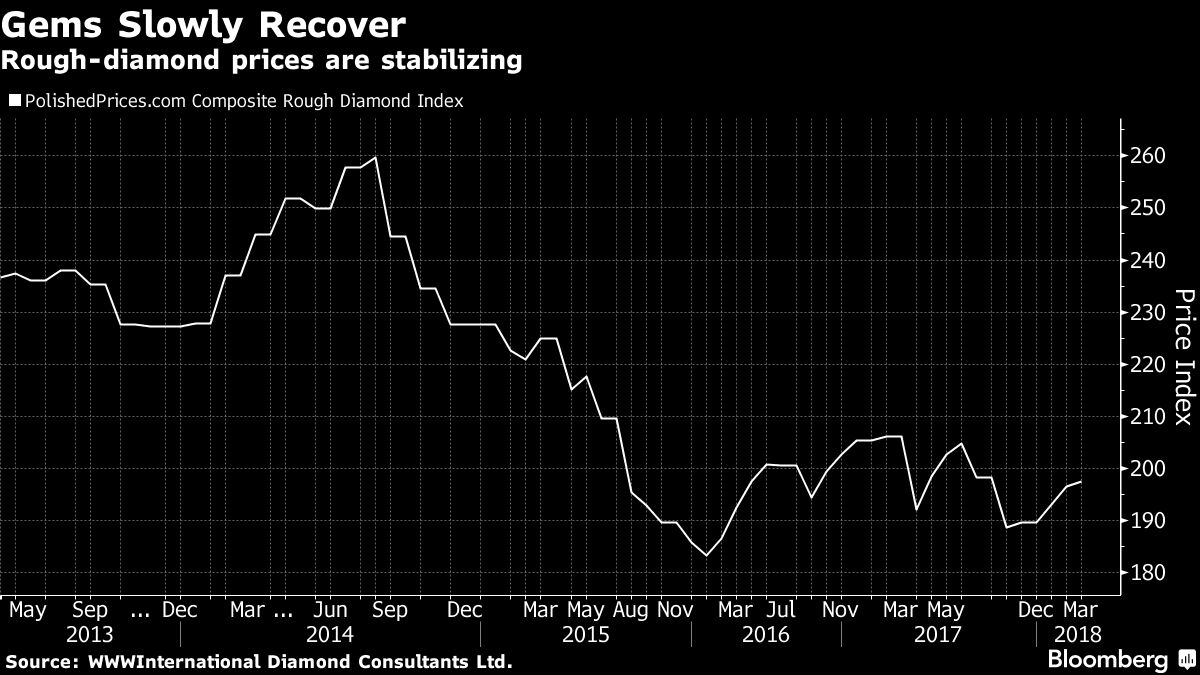Diamond News Archives
- Category: News Archives
- Hits: 2117
 (IDEX Online) – Botswana’s President, Mokgweetsi Masisi, is looking for a new long-term diamond deal with De Beers when the sides' current 10-year deal expires in 2020 which will include provisions for more stones to be cut and polished domestically.<?xml:namespace prefix = "o" ns = "urn:schemas-microsoft-com:office:office" /?> Both Botswana and De Beers have a strong incentive to reach a deal: Diamonds are a critical part of Botswana’s gross domestic product and foreign exchange earnings, while more than 60% of the miner's diamonds come from Botswana. Masisi, who is due to contest elections next year, is pushing for the industry to create more jobs and is “dead determined” that more diamonds be cut and polished in the country," he told Reuters. “We have had a wonderful relationship with De Beers and we expect that relationship to be even more cemented. There is a way of actually achieving a win-win for both, and that’s what we desire.” Botswana is the world’s biggest diamond producer after Russia, and most of its gems are mined by Debswana, a 50-50 joint venture between the government and De Beers. Anglo American owns 85 percent of De Beers, with Botswana’s government holding the rest. Masisi, 56, succeeded Ian Khama as president on April 1. He said that preparations for the talks are at an advanced stage, but declined to give details of the government’s proposals or whether it wanted to raise its stake in De Beers, saying he didn’t want to prejudice the negotiations. The new deal may differ from the previous one, because the circumstances and operating environment...
(IDEX Online) – Botswana’s President, Mokgweetsi Masisi, is looking for a new long-term diamond deal with De Beers when the sides' current 10-year deal expires in 2020 which will include provisions for more stones to be cut and polished domestically.<?xml:namespace prefix = "o" ns = "urn:schemas-microsoft-com:office:office" /?> Both Botswana and De Beers have a strong incentive to reach a deal: Diamonds are a critical part of Botswana’s gross domestic product and foreign exchange earnings, while more than 60% of the miner's diamonds come from Botswana. Masisi, who is due to contest elections next year, is pushing for the industry to create more jobs and is “dead determined” that more diamonds be cut and polished in the country," he told Reuters. “We have had a wonderful relationship with De Beers and we expect that relationship to be even more cemented. There is a way of actually achieving a win-win for both, and that’s what we desire.” Botswana is the world’s biggest diamond producer after Russia, and most of its gems are mined by Debswana, a 50-50 joint venture between the government and De Beers. Anglo American owns 85 percent of De Beers, with Botswana’s government holding the rest. Masisi, 56, succeeded Ian Khama as president on April 1. He said that preparations for the talks are at an advanced stage, but declined to give details of the government’s proposals or whether it wanted to raise its stake in De Beers, saying he didn’t want to prejudice the negotiations. The new deal may differ from the previous one, because the circumstances and operating environment...
- Category: News Archives
- Hits: 1706
Mike Maloney
MAY 14, 2018
Is silver going to be making a big move sometime soon? The evidence is building that the answer to that question might be yes. Join Mike Maloney for this latest update on the silver market....
- Category: News Archives
- Hits: 1248
Gold was slightly higher overnight, trading in a narrow range of $1318.40 - $1322.45. It ticked up to its high early during Asian hours, boosted by a pullback in the US dollar (92.58 – 92.36).
Unrest in the Middle East over the opening of a new US embassy in Jerusalem was supportive of the yellow metal, as was some slightly dovish commentary from the usually ultra-hawkish Loretta Mester of the Fed ("We want to give inflation time to move back to goal ... this argues against a steep path,").
However, gold drifted back to its low later during European time, hurt by rising global bond yields (German Bund from 0.551% to 0.609%, UK Gilts from 1.448% - 1.490%, US 10-year from 2.959% - 2.988%), and mostly firmer global equities.
The NIKKEI gained 0.5%, the SCI rose 0.4%, Eurozone shares declined from 0.2% - 0.4%, while S&P futures were +0.2%. A perceived thawing in US-China trade (Trump pledged Sunday to help Chinese frim ZTE to “get back into business” after a US ban had hamstrung the company) helped boost stocks, as did firmer oil (WTI from $70.50 - $70.80).
After the NY open, gold ticked down to $1318.15, but support in front of yesterday’s $1318 low and former quadruple top resistance held.
By mid-morning, the DX slipped further (92.26), weakened by strength in the euro from some hawkish commentary from the ECB’s Villeroy, Lautenschlaeger, and Praet (recent easing of price growth was likely temporary, signaling the ECB was still on course to withdraw its monetary stimulus).
Gold traded up to $1321.20 in response, and was also aided by reports of increased violence in Gaza over the new US embassy (dozens of Palestinians killed, over 2k wounded), and some dovish comments by the Fed’s...
- Category: News Archives
- Hits: 1700
Few remember the nuts and bolts of how the banks got bailed out in 2008. It shouldn’t have happened, and in fact, the bailout bill didn’t pass in Congress. The Dow dropped 740 points from its highs of the day to the lows on September 29.
Immediately following this, certain ‘no’-voting Congressmen were backroomed and told by Wall St. scion Hank Paulson that, in no uncertain terms, the global economy was about to fail. Essentially, the world was ending, and it was their fault, and they had no choice whatsoever but to vote for the bailout. A revote was held. A near-identical bailout bill passed on October 3.
Ironically, the market was roughly unchanged from where it was when the first bailout bill failed, when the second bailout bill passed. Only then, once all was supposedly saved, did the market promptly crater, losing over 20% in a week, as the Dow plummeted from 10,500 to 8,000 over five trading days.
Wall St. forced Congress, by threat of financial Armageddon, to bail them out. We are well served to remember that when push comes to shove, Congress serves at the whim and pleasure of Wall St. Not vice versa.
I boldly assert that bankers (meaning the private finance sector) can be blamed for the Great Financial Crisis and for the economic policies implemented after the crisis. By bribing and intimidating the political class, most notably in the US, financiers achieved, and still enjoy, self-regulating, global markets in finance.

After the Great Financial Crisis of 2007-9, it was the finance sector that lobbied politicians into bailing out the private financial system. The system was on the brink of collapse, with the very real threat that hundreds of millions of deposit-holders would not...
- Category: News Archives
- Hits: 1652
(Bloomberg) — Alrosa PJSC, the world’s largest diamond miner by output, is increasing its marketing efforts and targeting new opportunities in gem cutting at a time when the market is showing signs of starting to stabilize.
The Russian firm, which typically hasn’t promoted stones outside Russia, last year contributed $25 million to the Diamond Producers Association for marketing and may increase sponsorship this year, Chief Executive Officer Sergey Ivanov said. Alrosa also plans to focus more on cutting premium stones and may consider buying Russia’s top polisher if it gets privatized.
Alrosa has traditionally focused on rough-diamond mining but is gradually changing its business after Ivanov, 37, became CEO a year ago. One of the rare steps it has taken in the past year include traveling the world to promote the auction of five gems cut from a giant diamond. While the industry has struggled with stagnant consumer demand, the market benefited from a stronger-than-expected end to 2017.
"DPA basically started to work at the end of the fourth quarter," and this was in time for Christmas sales, Ivanov said in an interview in Moscow, referring to the association it established with De Beers and other miners in 2015. “The first-quarter sales were very good.”
That helped Alrosa reduce its 18 million carats of inventories by 30 percent from the start of the year to a seven-year low, as well as raising average prices by several percent, the CEO said.

As part of its promotion strategy, Alrosa is working with researchers to show that so-called fluorescent stones, which are often sold at a large discount and shunned by younger buyers, in many cases have better color and luster than normal gems, Ivanov said. Alrosa has “a lot” of such stones at...

